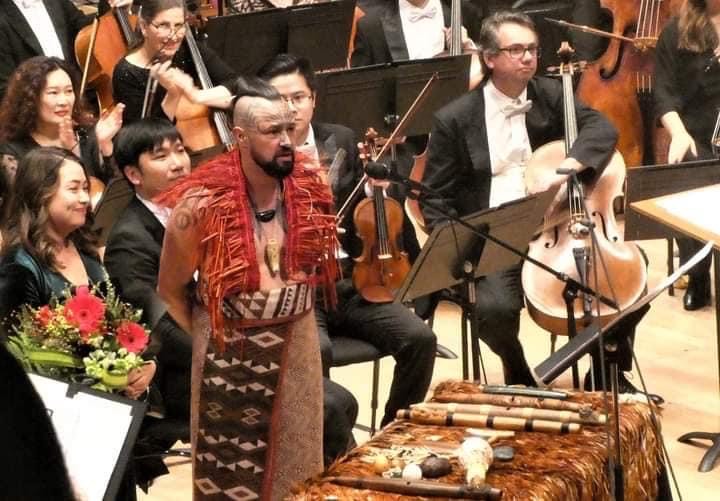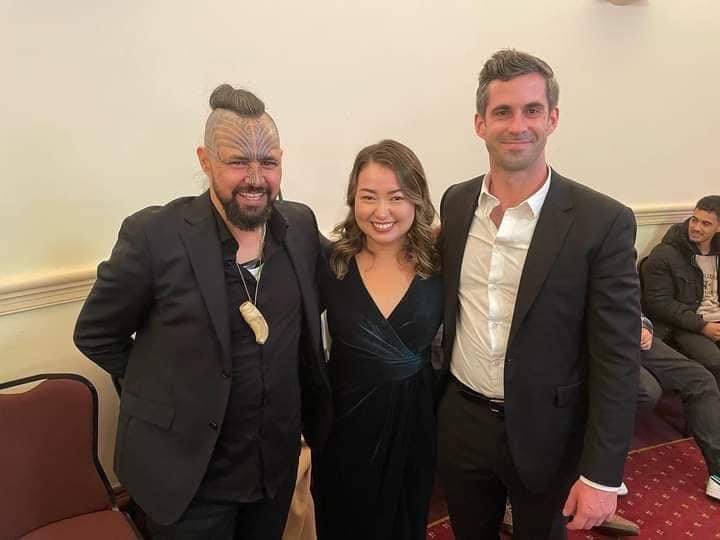SOUNZ caught up with Salina Fisher and Jerome Kavanagh, co-creators of Papatūānuku, a work for taonga pūoro and orchestra premiered in August 2023 by Jerome and the Auckland Philharmonia Orchestra, ahead of this month’s release of a film of this performance.
Can you tell us about how Papatūānuku came about and the inspiration behind the work?
Salina: I’d been dreaming of a sound world of taonga pūoro supported by orchestra for a long time, so when APO approached me about a concerto commission, I floated my idea with them, which they immediately embraced. In the years leading up to this piece, Jerome and I had spent a lot of time together, collaborating musically in a number of different contexts and becoming close friends. I had become familiar with Jerome’s incredible musicianship through improvising with him on violin and koto, and it was a dream to be able to take that collaborative relationship to the next level, to make music together through an entire orchestra. I am in awe of Jerome as a musician and as a person, and I’m deeply honoured to have built such a strong foundation together before co-creating this major new work.
Jerome: Papatūānuku came about after Salina was invited by The APO to compose a piece for their 2023 season. Through the generosity of Salina she then asked me to co-compose the piece alongside her. We met to discuss what that might sound and feel like.
At the time my partner Ruiha was pregnant with our baby boy Tawhirirangi and so we began to discuss how we might honour the Mana of our Wahine and the fact that women carry and birth all of humanity since the beginning of time. We discussed the effects of colonisation and how that process has created an imbalance in the world and severely oppressed and devalued women. All of these conversations lead us back to the first mother of us all, “Papatūānuku”, and so we wanted to bring awareness and aroha for Papatūānuku and for our Wahine.
The inspiration and entire kaupapa is “Papatūānuku” herself, we wanted to create a piece that would forever honour and raise up Papatūānuku in the hearts and minds of all people who might listen. We wanted to be able to perform the piece for and to Papatūānuku first and foremost and then to the audience secondly to remind everyone this is our mother and we need to do better in taking care of her as she takes care of us.
Salina: Every instrument that Jerome plays is so closely connected with Papatūānuku. As Jerome has mentioned, we wanted to honour and uplift her by featuring these unique voices of the natural world, supported and nurtured sonically through sensitive and subtle orchestral scoring. We talked about the personification of earth as a woman and as a ‘mother’ across different cultures, of Papatūānuku as the bearer of all life, and the imbalance created by the exploitation and devaluing of both women and the natural world. In te ao Māori, there is a profound interconnectedness between wāhine and whenua, where 'whenua' means both land and placenta. We were bringing this piece into the world during an incredibly special time, as Jerome’s partner Ruiha was hapū with their baby Tawhirirangi. Several taonga featured in this piece are directly linked to birthing. One example is the pūmotomoto, an end-blown wooden flute that is traditionally played towards a newborn’s fontanelle as it closes.

There is a harmonious synergy between Jerome’s solo part and the music composed by Salina for the orchestra. Can you tell us about how you worked together to create this sense of unity between these two elements?
Jerome: Firstly, the music is a co-composition created by both of us in equal parts of importance. The process started by taking my Taonga Puoro compositions, which I have been developing for the past 20 years. I have walked and sat within my ancestral homelands of Awarua - Mokai Patea with my Taonga Puoro and those sound signatures have come from being in those spaces, by being in nature, and bowing down in great reverence to the power of nature. That's how I’ve been taught to compose - by being in direct contact and relationship with the Taiao.
Salina and I spent the day at Lilburn house towards the end of my residency recording my Taonga Puoro compositions. I feel like it's best to leave Salina to explain, but what I will say is that we wanted to work in a new way that is truly a partnership honouring Taonga Puoro and Classical music as both equal in value. For a long time Taonga Puoro has been seen as less than and perhaps not as valued or prestigious as classical or modern music. Papatūānuku is a composition that places Taonga Puoro at the front and centre of the composition and Salina skillfully and carefully wraps the orchestra sound around our Taonga Puoro. In my opinion, Salina is one of our greatest modern living composers of Aotearoa, not only because of her skill but also because she has the integrity, vision, and whakaaro rangatira to create such a change in the way we view and practice music-making in Aotearoa.
Salina: Thank you so much Jerome. Yes, our piece is very much a co-composition: Jerome is the composer of the taonga pūoro part, and I’ve written the orchestral part that wraps around him. I wanted to make sure that it was an authentic and respectful collaboration right from the beginning. I had no interest in trying to make taonga pūoro “fit” around an orchestral part; it was important to me that it was actually the other way around – a “taonga pūoro first” approach. After the day of recording at Lilburn House that Jerome mentioned, I spent time transcribing at least an hour’s worth of audio of all of Jerome’s unique taonga, becoming intimately familiar with their sounds according to the way Jerome plays them. I imagined the kinds of harmonies and textures that could most naturally support them, and came up with a musical structure for the piece that allows seamless transitions between the 19 different featured instruments. Due to the improvising nature of taonga pūoro performance, I kept in mind that Jerome wouldn’t be playing exactly what he played in the recordings I was working from – I was designing sonic ‘environments’ that would theoretically support anything he might play on that instrument in the moment. Of course each instrument has a very specific range with particularly resonant pitches (some with multiple voices), so for the piece to work, the cues and timings of each entry are very specific. There was a lot of very technical and logistical groundwork involved in making the orchestral part work harmoniously with the pūoro part, but once that was figured out, I could delve into finding a language that reflected the ‘nurturing’ qualities of Papatūānuku. I feel like the ‘harmonious synergy’ between our parts is a reflection of the trust we’ve built through all our collaborations leading to this, and the culmination of many years of mahi between us.
What does it mean to you both to have worked together on a piece for taonga puoro and orchestra on this scale?
Jerome: Working together with Salina to create Papatūānuku is my favourite collaboration of all time. We are great friends so for me our process was beautiful in its heart because we have a mutual respect and care for each other and each other's work. It means the world to me and I feel like this provides an example for the next generation of an approach of authenticity on so many levels. We have a lot more to offer the world here in Aotearoa musically if we can stand in the mana of who we are and be proud of that together. I feel like Papatūānuku is a next level and an absolute and unapologetic Aotearoa sound and kaupapa that demonstrates that we are who we are and that is more than enough.
Salina: This is definitely the largest-scale project I’ve ever been part of, and it is the honour of a lifetime. I first started my journey into taonga pūoro over eight years ago and it immediately became a very special and meaningful part of my life. The revival and normalisation of the indigenous instruments of this land are incredibly important to me, and their sounds and stories resonate with me deeply. I have been exploring ways that I can contribute meaningfully and respectfully during this pivotal time for this art form, and I’m grateful to the wonderful taonga pūoro musicians who have been so open and caring in guiding me. The piece itself, what it represents, and all of the love and care that went into it before a single note was written, means more than I can ever put into words.

How did you feel at the premiere of Papatūānuku as it came to life in front of an audience?
Jerome: It was nothing short of amazing. For all those that came to be a part of that night, the atmosphere was magic and almost surreal. We had some challenges that we faced leading up to the performance but once we were there with everyone, it went like a dream. It is still one of my most memorable live performances. The players in the orchestra were amazing and a joy to work alongside. Vince Hardaker, the conductor, was amazing and was really thoughtful. The sound engineers did a fantastic job too. Everyone worked together to honour Papatūānuku and we are really looking forward to seeing Chris Watson’s film which we feel grateful for. We did some things that were different at the beginning of the performance again to try and bring an Authentic Aotearoa way into the industry and that was created by us all which I'm so excited for everyone to see in the film. What made it even more special for me was that my whanau in Halcombe were listening to the RNZ live broadcast at home and Salina was in the audience with her whanau also. It was so important for her to be there for the performance and her guidance, suggestions and tautoko were beautiful. We had a standing ovation from the beautiful audience and Salina came up to receive her flowers and we shared hongi and a big hug. For me was very emotional and made me cry, a beautiful feeling that it had all come together so well for us all and for our earth mother “Papatūānuku”.
Salina: It was an absolutely magical experience; one I’ll remember for the rest of my life. It’s a strange and exciting thing as a composer to sit in the audience and experience the first-ever performance of a piece at the exact same time as hundreds of other people. I felt relaxed though, being able to fully trust everyone on stage, and also knowing that spontaneity is an essential part of the piece. I was already very happy with how it sounded at the dress rehearsal, but the excitement and magic of a performance setting took it to a completely new level. Jerome, Vince, and the APO musicians all worked together so seamlessly in bringing the music to life. My whānau and some close friends came to Auckland especially for the performance, and it was also amazing to be able to share the experience in real-time with friends around the world through RNZ’s live broadcast of the concert. We had a wonderful response from the audience. We are so excited for the film to be out in the world – thank you Chris Watson and SOUNZ!

Do you have any future plans for Papatūānuku?
Jerome: Yes, but at the moment we cant say too much, except watch this space both here in Aotearoa and overseas.
Salina: Watch this space!

